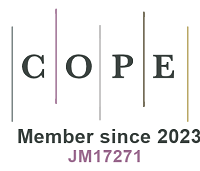REFERENCES
1. García J, García-Galán MJ, Day JW, et al. A review of emerging organic contaminants (EOCs), antibiotic resistant bacteria (ARB), and antibiotic resistance genes (ARGs) in the environment: increasing removal with wetlands and reducing environmental impacts. Bioresour Technol 2020;307:123228.
2. Bilal M, Mehmood S, Rasheed T, Iqbal HM. Antibiotics traces in the aquatic environment: persistence and adverse environmental impact. Curr Opin Environ Sci Health 2020;13:68-74.
3. Storto D, Nara LBC, Kozusny-andreani DI, et al. Seasonal dynamics of microbial contamination and antibiotic resistance in the water at the Tietê Ecological Park, Brazil. Water Air Soil Pollut 2021:232.
4. Grenni P, Ancona V, Barra Caracciolo A. Ecological effects of antibiotics on natural ecosystems: a review. Microchem J 2018;136:25-39.
5. Qaswar M, Yiren L, Jing H, et al. Soil nutrients and heavy metal availability under long-term combined application of swine manure and synthetic fertilizers in acidic paddy soil. J Soils Sediments 2020;20:2093-106.5.
6. Bilal M, Ashraf SS, Barceló D, Iqbal HMN. Biocatalytic degradation/redefining “removal” fate of pharmaceutically active compounds and antibiotics in the aquatic environment. Sci Total Environ 2019;691:1190-211.
7. Bilal M, Rizwan K, Adeel M, Barceló D, Awad YA, Iqbal HMN. Robust strategies to eliminate endocrine disruptive estrogens in water resources. Environ Pollut 2022;306:119373.7.
8. González-González RB, Sharma A, Parra-Saldívar R, Ramirez-Mendoza RA, Bilal M, Iqbal HMN. Decontamination of emerging pharmaceutical pollutants using carbon-dots as robust materials. J Hazard Mater 2022;423:127145.8.
9. Chaturvedi P, Shukla P, Giri BS, et al. Prevalence and hazardous impact of pharmaceutical and personal care products and antibiotics in environment: a review on emerging contaminants. Environ Res 2021;194:110664.
10. Zuo R, Liu X, Zhang Q, et al. Sulfonamide antibiotics in groundwater and their migration in the vadose zone: a case in a drinking water resource. Ecol Eng 2021;162:106175.
11. Szekeres E, Chiriac CM, Baricz A, et al. Investigating antibiotics, antibiotic resistance genes, and microbial contaminants in groundwater in relation to the proximity of urban areas. Environ Pollut 2018;236:734-44.
12. PubChem. Available from: https://pubchem.ncbi.nlm.nih.gov/ [Last accessed on 9 Feb 2023].
13. Drugs.com. Available from: https://www.drugs.com/ [Last accessed on 9 Feb 2023].
14. DrugBank Online. Available from: https://go.drugbank.com/ [Last accessed on 9 Feb 2023].
15. Zhang X, Guo W, Ngo HH, Wen H, Li N, Wu W. Performance evaluation of powdered activated carbon for removing 28 types of antibiotics from water. J Environ Manage 2016;172:193-200.
16. Aguilar-pérez K, Avilés-castrillo J, Ruiz-pulido G. Nano-sorbent materials for pharmaceutical-based wastewater effluents - an overview. Case Stud Chem Environ Eng 2020;2:100028.
17. Aguilar-Pérez KM, Avilés-Castrillo JI, Ruiz-Pulido G, Medina DI, Parra-Saldivar R, Iqbal HMN. Nanoadsorbents in focus for the remediation of environmentally-related contaminants with rising toxicity concerns. Sci Total Environ 2021;779:146465.
18. Gopinath KP, Vo DN, Gnana Prakash D, Adithya Joseph A, Viswanathan S, Arun J. Environmental applications of carbon-based materials: a review. Environ Chem Lett 2021;19:557-82.
19. Araújo RG, González-González RB, Martinez-Ruiz M, et al. Expanding the scope of nanobiocatalysis and nanosensing: applications of nanomaterial constructs. ACS Omega 2022;7:32863-76.
20. Cruz-cruz A, Gallareta-olivares G, Rivas-sanchez A, et al. Recent advances in carbon dots based biocatalysts for degrading organic pollutants. Curr Pollution Rep 2022;8:384-94.20.
21. González-González RB, Parra-Saldívar R, Alsanie WF, Iqbal HMN. Nanohybrid catalysts with porous structures for environmental remediation through photocatalytic degradation of emerging pollutants. Environ Res 2022;214:113955.
22. González-González RB, Flores-Contreras EA, Parra-Saldívar R, Iqbal HMN. Bio-removal of emerging pollutants by advanced bioremediation techniques. Environ Res 2022;214:113936.
23. Rivas-Sanchez A, Cruz-Cruz A, Gallareta-Olivares G, González-González RB, Parra-Saldívar R, Iqbal HMN. Carbon-based nanocomposite materials with multifunctional attributes for environmental remediation of emerging pollutants. Chemosphere 2022;303:135054.
24. Rodríguez-hernández JA, Araújo RG, López-pacheco IY, et al. Environmental persistence, detection, and mitigation of endocrine disrupting contaminants in wastewater treatment plants - a review with a focus on tertiary treatment technologies. Environ Sci Adv 2022;1:680-704.
25. Mashkoor F, Nasar A, Inamuddin. Carbon nanotube-based adsorbents for the removal of dyes from waters: a review. Environ Chem Lett 2020;18:605-29.
26. Bhuyan MSA, Uddin MN, Islam MM, Bipasha FA, Hossain SS. Synthesis of graphene. Int Nano Lett 2016;6:65-83.
27. Papageorgiou DG, Kinloch IA, Young RJ. Mechanical properties of graphene and graphene-based nanocomposites. Prog Mater Sci 2017;90:75-127.
28. Akinwande D, Brennan CJ, Bunch JS, et al. A review on mechanics and mechanical properties of 2D materials - Graphene and beyond. Extreme Mech Lett 2017;13:42-77.
29. Gupta N, Gupta SM, Sharma SK. Carbon nanotubes: synthesis, properties and engineering applications. Carbon Lett 2019;29:419-47.
30. Rahman G, Najaf Z, Mehmood A, et al. An overview of the recent progress in the synthesis and applications of carbon nanotubes. C J Carbon Res 2019;5:3.
31. Kar KK. Handbook of nanocomposite supercapacitor materials II. Cham: Springer International Publishing; 2020.
32. Cha JS, Park SH, Jung S, et al. Production and utilization of biochar: a review. J Ind Eng Chem 2016;40:1-15.
34. Leng L, Xiong Q, Yang L, et al. An overview on engineering the surface area and porosity of biochar. Sci Total Environ 2021;763:144204.
35. Mansour F, Al-hindi M, Yahfoufi R, Ayoub GM, Ahmad MN. The use of activated carbon for the removal of pharmaceuticals from aqueous solutions: a review. Rev Environ Sci Biotechnol 2018;17:109-45.
36. Lesaoana M, Mlaba R, Mtunzi F, Klink M, Ejidike P, Pakade V. Influence of inorganic acid modification on Cr(VI) adsorption performance and the physicochemical properties of activated carbon. S Afr J Chem Eng 2019;28:8-18.
37. Ji L, Chen W, Xu Z, Zheng S, Zhu D. Graphene nanosheets and graphite oxide as promising adsorbents for removal of organic contaminants from aqueous solution. J Environ Qual 2013;42:191-8.
38. Li MF, Liu YG, Zeng GM, Liu N, Liu SB. Graphene and graphene-based nanocomposites used for antibiotics removal in water treatment: a review. Chemosphere 2019;226:360-80.
39. Moradi SE. Highly efficient removal of amoxicillin from water by magnetic graphene oxide adsorbent. Available from: http://chemicalbulletin.upt.ro/admin/articole/72848art_3(41-48).pdf [Last accessed on 9 Feb 2023].
40. Yusuf M, Elfghi FM, Zaidi SA, Abdullah EC, Khan MA. Applications of graphene and its derivatives as an adsorbent for heavy metal and dye removal: a systematic and comprehensive overview. RSC Adv 2015;5:50392-420.
41. Jian M, Xie H, Xia K, Zhang Y. Challenge and opportunities of carbon nanotubes. Industrial applications of carbon nanotubes. Elsevier; 2017. pp. 433-76.
42. Song W, Yang T, Wang X, et al. Experimental and theoretical evidence for competitive interactions of tetracycline and sulfamethazine with reduced graphene oxides. Environ Sci Nano 2016;3:1318-26.
43. Zhang Y, Jiao Z, Hu Y, et al. Removal of tetracycline and oxytetracycline from water by magnetic Fe3O4@graphene. Environ Sci Pollut Res Int 2017;24:2987-95.
44. Bai L, Li Z, Zhang Y, et al. Synthesis of water-dispersible graphene-modified magnetic polypyrrole nanocomposite and its ability to efficiently adsorb methylene blue from aqueous solution. Chem Eng J 2015;279:757-66.
45. Yao N, Li C, Yu J, et al. Insight into adsorption of combined antibiotic-heavy metal contaminants on graphene oxide in water. Sep Purif Technol 2020;236:116278.
46. Rostamian R, Behnejad H. A comprehensive adsorption study and modeling of antibiotics as a pharmaceutical waste by graphene oxide nanosheets. Ecotoxicol Environ Saf 2018;147:117-23.
47. Gao Y, Li Y, Zhang L, et al. Adsorption and removal of tetracycline antibiotics from aqueous solution by graphene oxide. J Colloid Interf Sci 2012;368:540-6.
48. Jia X, Li S, Wang Y, Wang T, Hou X. Adsorption behavior and mechanism of sulfonamide antibiotics in aqueous solution on a novel MIL-101(Cr)@GO composite. J Chem Eng Data 2019;64:1265-74.48.
49. Carrales-alvarado D, Rodríguez-ramos I, Leyva-ramos R, Mendoza-mendoza E, Villela-martínez D. Effect of surface area and physical-chemical properties of graphite and graphene-based materials on their adsorption capacity towards metronidazole and trimethoprim antibiotics in aqueous solution. Chem Eng J 2020;402:126155.
50. Salihi E, Wang J, Kabacaoğlu G, Kırkulak S, Šiller L. Graphene oxide as a new generation adsorbent for the removal of antibiotics from waters. Sep Sci Technol 2021;56:453-61.
51. Liu Y, Huang S, Zhao X, Zhang Y. Fabrication of three-dimensional porous β-cyclodextrin/chitosan functionalized graphene oxide hydrogel for methylene blue removal from aqueous solution. Colloids Surf A Physicochem Eng Asp 2018;539:1-10.
52. Yao Q, Fan B, Xiong Y, Jin C, Sun Q, Sheng C. 3D assembly based on 2D structure of cellulose nanofibril/graphene oxide hybrid aerogel for adsorptive removal of antibiotics in water. Sci Rep 2017;7:45914.
53. Vithanage M, Mayakaduwa SS, Herath I, Ok YS, Mohan D. Kinetics, thermodynamics and mechanistic studies of carbofuran removal using biochars from tea waste and rice husks. Chemosphere 2016;150:781-9.
54. Zhang Y, Cao B, Zhao L, et al. Biochar-supported reduced graphene oxide composite for adsorption and coadsorption of atrazine and lead ions. Appl Surf Sci 2018;427:147-55.
55. Zhang A, Li X, Xing J, Xu G. Adsorption of potentially toxic elements in water by modified biochar: a review. J Environ Chem Eng 2020;8:104196.
56. Wu L, Wei C, Zhang S, Wang Y, Kuzyakov Y, Ding X. MgO-modified biochar increases phosphate retention and rice yields in saline-alkaline soil. J Clean Prod 2019;235:901-9.
57. Xu J, Cao Z, Wang Y, et al. Distributing sulfidized nanoscale zerovalent iron onto phosphorus-functionalized biochar for enhanced removal of antibiotic florfenicol. Chem Eng J 2019;359:713-22.
58. Liu S, Xu WH, Liu YG, et al. Facile synthesis of Cu(II) impregnated biochar with enhanced adsorption activity for the removal of doxycycline hydrochloride from water. Sci Total Environ 2017;592:546-53.
59. Gholami P, Dinpazhoh L, Khataee A, Hassani A, Bhatnagar A. Facile hydrothermal synthesis of novel Fe-Cu layered double hydroxide/biochar nanocomposite with enhanced sonocatalytic activity for degradation of cefazolin sodium. J Hazard Mater 2020;381:120742.
60. Fu C, Zhang H, Xia M, Lei W, Wang F. The single/co-adsorption characteristics and microscopic adsorption mechanism of biochar-montmorillonite composite adsorbent for pharmaceutical emerging organic contaminant atenolol and lead ions. Ecotoxicol Environ Saf 2020;187:109763.
61. Ashiq A, Sarkar B, Adassooriya N, et al. Sorption process of municipal solid waste biochar-montmorillonite composite for ciprofloxacin removal in aqueous media. Chemosphere 2019;236:124384.
62. Hu X, Xue Y, Long L, Zhang K. Characteristics and batch experiments of acid- and alkali-modified corncob biomass for nitrate removal from aqueous solution. Environ Sci Pollut Res Int 2018;25:19932-40.
63. Ma Y, Li P, Yang L, et al. Iron/zinc and phosphoric acid modified sludge biochar as an efficient adsorbent for fluoroquinolones antibiotics removal. Ecotoxicol Environ Saf 2020;196:110550.
64. Wang B, Gao B, Fang J. Recent advances in engineered biochar productions and applications. Crit Rev Environ Sci Technol 2017;47:2158-207.
65. Qin Y, Zhu X, Su Q, et al. Enhanced removal of ammonium from water by ball-milled biochar. Environ Geochem Health 2020;42:1579-87.
66. Huang J, Zimmerman AR, Chen H, Gao B. Ball milled biochar effectively removes sulfamethoxazole and sulfapyridine antibiotics from water and wastewater. Environ Pollut 2020;258:113809.
67. Xiang W, Wan Y, Zhang X, et al. Adsorption of tetracycline hydrochloride onto ball-milled biochar: governing factors and mechanisms. Chemosphere 2020;255:127057.
68. Sabzehmeidani MM, Mahnaee S, Ghaedi M, Heidari H, Roy VAL. Carbon based materials: a review of adsorbents for inorganic and organic compounds. Mater Adv 2021;2:598-627.
69. Nazal MK. An overview of carbon-based materials for the removal of pharmaceutical active compounds. In: Bartoli M, Frediani M, Rosi L, editors. Carbon-based material for environmental protection and remediation. IntechOpen; 2020.
70. Yu F, Sun S, Han S, Zheng J, Ma J. Adsorption removal of ciprofloxacin by multi-walled carbon nanotubes with different oxygen contents from aqueous solutions. Chem Eng J 2016;285:588-95.
71. Mousavi SA, Janjani H. Antibiotics adsorption from aqueous solutions using carbon nanotubes: a systematic review. Toxin Reviews 2020;39:87-98.
72. Azarpira H, Mahdavi Y, Khaleghi O, Balarak D. Thermodynamic studies on the removal of metronidazole antibiotic by multi-walled carbon nanotubes. Available from: https://www.scholarsresearchlibrary.com/articles/thermodynamic-studies-on-the-removal-of-metronidazole-antibiotic-by-multiwalled-carbon-nanotubes.pdf [Last accessed on 9 Feb 2023].
73. Shaban MAA, Ibrahim MA, M-ridha MJ, Hussein HA. Adsorption of meropenem antibiotics from aqueous solutions on multi-walled carbon nanotube. Int Rev Civ Eng 2020;11:283-93.
74. Gaálová J, Bourassi M, Soukup K, et al. Modified single-walled carbon nanotube membranes for the elimination of antibiotics from water. Membranes 2021;11:720.
75. Martins AC, Pezoti O, Cazetta AL, et al. Removal of tetracycline by NaOH-activated carbon produced from macadamia nut shells: Kinetic and equilibrium studies. Chem Eng J 2015;260:291-9.
76. Marzbali MH, Esmaieli M, Abolghasemi H, Marzbali MH. Tetracycline adsorption by H3PO4-activated carbon produced from apricot nut shells: a batch study. Process Saf Environ Prot 2016;102:700-9.
77. Acosta R, Fierro V, Martinez de Yuso A, Nabarlatz D, Celzard A. Tetracycline adsorption onto activated carbons produced by KOH activation of tyre pyrolysis char. Chemosphere 2016;149:168-76.
78. Ahmed MJ. Adsorption of quinolone, tetracycline, and penicillin antibiotics from aqueous solution using activated carbons. Environ Toxicol Pharmacol 2017;50:1-10.
79. Balarak D, Mahvi AH, Shahbaksh S, Wahab MA, Abdala A. Adsorptive removal of azithromycin antibiotic from aqueous solution by azolla filiculoides-based activated porous carbon. Nanomaterials 2021;11:3281.
80. Al-musawi TJ, Mahvi AH, Khatibi AD, Balarak D. Effective adsorption of ciprofloxacin antibiotic using powdered activated carbon magnetized by iron(III) oxide magnetic nanoparticles. J Porous Mater 2021;28:835-52.







